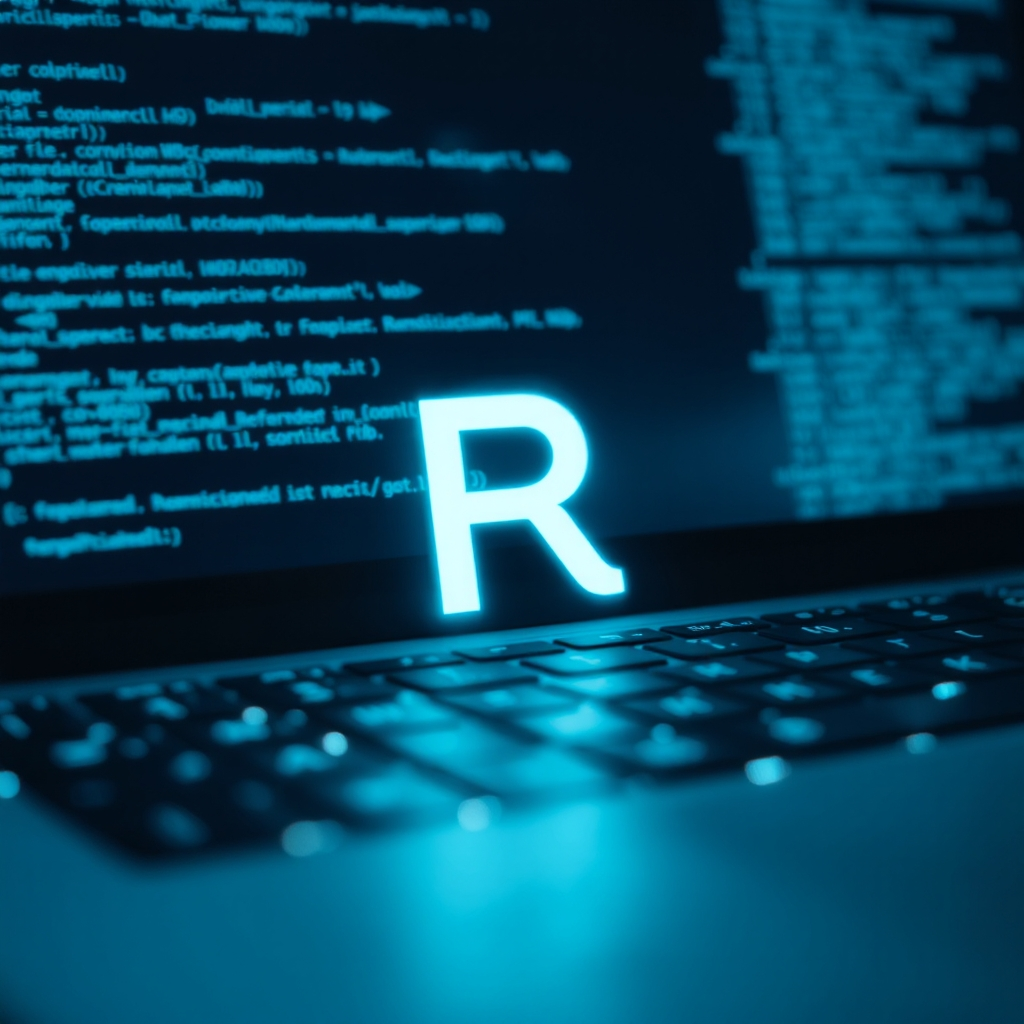

- Éducation
R Programming: Examples, Tutorials, and Complete Beginner’s Guide
Hello everyone, I hope all is well with you.
I’m S. K. from E-newcademy, and I want to discuss the R programming language with you.
I’ve extensively used the R programming language, finding it highly enjoyable for learning R programming enthusiasts,
Introducing R programming for beginners: with only 25 hours of practice, you can start building real R programming examples and gain confidence quickly.
R is a programming language and free software specialized in statistics and data science created at the University of Auckland.
This language is highly regarded for its simplicity, efficiency, and accessibility, and can be used in Visual Studio, Rstudio, or via Jupyter notebook.
Today, R is more versatile than it was in the 1990s and still has a strong community and projects available on GitHub.
Curious about R programming for data science applications before starting learn R programming?
Let’s get started!
1 – Data visualisation
Data science means data visualization!
R excels in this area and is a very good language for high-level data visualization.
Not only will you be able to manipulate and visualize large amounts of data, but you will also be able to vary the types of visualization.
In fact, the possibilities are as rich as they are in Python.
You can obtain data visualizations in areas, curves, heat maps, or even pie charts.
Plus, R programming for data science enables geographic mapping for enhanced data visualization in R.
For example, you can use a map of Canada subdivided into several provinces with different shades.
In addition, you can generate fully interactive and dynamic visualizations.
To do this, I highly recommend using ggplot 2, which is an excellent R library :
# Instance of simple using of ggplot2
library(ggplot2)
data <- data.frame(
category = c(“A”, “B”, “C”, “D”),
value = c(10, 23, 15, 8)
)
ggplot(data, aes(x = category, y = value, fill = category)) +
geom_bar(stat = “identity”) +
theme_minimal() +
labs(title = “Exemple de visualisation avec R ggplot2”)
From experience, I have been able to import and use it successfully, particularly on small projects such as my map of the United States for data visualization.
For geographic data, I recommend using the “leaflet” library, which is much more suitable.
Want to get comfortable with data visualization in R and ggplot 2?
Check out our free MOOC on the subject, which is fully available.
2 – Creating a website
I did a demonstration on TikTok in December 2024.
While R is not a replacement for HTML or JavaScript, with the R Shiny framework you can build interactive dashboards and R programming examples for web applications
All you need to do is use the Shiny library, which is a versatile library that gives you lots of possibilities :
# Example of shiny using
library(shiny)
ui <- fluidPage(
titlePanel(“Hello Shiny!”),
sidebarLayout(
sidebarPanel(
sliderInput(“num”, “Choose a number:”, 1, 100, 50)
),
mainPanel(
textOutput(“result”)
)
)
)
server <- function(input, output) {
output$result <- renderText({
paste(“You selected:”, input$num)
})
}
shinyApp(ui = ui, server = server)
The use of R for creating websites and web applications is particularly widespread in the public sector and education.
In my personal experience, creating a website with R via Shiny can be interesting because you can make beautiful, dynamic, and highly interactive pages.
However, it’s still a good idea for landing pages or websites that require few resources.
R is great for interactive pages, but it cannot create fast, high-performance websites if there are too many elements to include, unlike PHP.
For large website projects that require a lot of elements and data, it is better to fall back on languages such as React for the front end or Golang for the back end.
You can also create small mini-game projects in R using Shiny.
However, for more elaborate games, I recommend using Java, C++, C#, or Rust, as R is not designed for game development.
Want to see some website projects made in R via Shiny? Check out the official website.
3 – R for ML and AI
Like Python, you can easily do machine learning and create artificial intelligence using the basic data science features in R.
Want to create your next chatbot or an image generator like Midjourney?
You’re in for a treat!
R offers several packages for AI and ML, such as Caret, Keras, H2O, and Random Forest :
# Simple instance
library(caret)
# Jeu de données intégré (iris)
data(iris)
# Séparation train/test
set.seed(123)
trainIndex <- createDataPartition(iris$Species, p = 0.8, list = FALSE)
trainData <- iris[trainIndex, ]
testData <- iris[-trainIndex, ]
# Modèle avec Random Forest
model <- train(Species ~ ., data = trainData, method = “rf”)
# Prédiction
predictions <- predict(model, newdata = testData)
# Évaluation
confusionMatrix(predictions, testData$Species)
Be careful, though: not all packages are created equal, and you’ll need to choose one that’s relevant to your AI project.
Caret and H20 are highly scalable and are great for big data or for obtaining a variety of ML algorithms.
For deep learning, Keras remains a good solution.
R offers good solutions for supervised learning, unsupervised learning, and reinforcement learning.
R programming has been widely adopted in research, finance, and academia. For example, many R programming code examples are available on GitHub, covering AI, statistics, and visualization., showcasing R for data science,
You can also create different types of AI projects such as chatbots for customer relations, product recommendations, web search AI, and traffic alerts.
Even while R might not be the most popular programming language for artificial intelligence, it has many advantages. R offers a number of libraries and packages to help with artificial intelligence development. This feature is helpful when creating machine learning models because of its well-known powerful data analysis capabilities. R can be used to create applications in a variety of specific fields of artificial intelligence, such as computer vision, natural language processing, and predictive modeling. Another advantage of using R for programming is that there is a sizable user base available online to offer assistance if you run into issues or have concerns.
Ready to learn R programming for machine learning in R and AI projects?
We suggest you this video our partner Edureka :
4 – Generation of reports and documents
Want to create automated, dynamic, interactive, and comprehensive reports in HTML, PDF, or Word?
It’s possible and easy to do. R can be very useful for this purpose, even in fields where coding is not used, such as business or administration.
Use R Markdown to automate this task quickly :
—
—
title: “Exemple de rapport automatisé”
output: html_document
—
“`{r}
# R programming example of automated report with R Markdown
library(ggplot2)
ggplot(mtcars, aes(x = wt, y = mpg)) +
geom_point() +
labs(title = “Automated report with R Markdown”)
—
> *“As for software, you can create R packages that can be used separately outside of R and shared on GitHub.”*
**Snippet R :**
“`r
# R programming example: create a simple R package
install.packages(“devtools”)
library(devtools)
# Create a new R package skeleton named “monPackage”
create(“monPackage”)
You can create reports for your colleagues that are rich in varied information, including text, of course, but also lots of numerical data and different types of graphs.
You can create elaborate reports such as infographics or any type of information with symbols and nuances to make the information accessible and readable.
If you are just starting out and are not comfortable with code, I suggest you begin with a small project to generate reports with R. You can start with short reports.
I recommend visiting https://larmarange.github.io/analyse-R/rmarkdown-les-rapports-automatises.html, which offers comprehensive information to teach you how to generate high-quality reports in R step by step, accessible to beginners.
5 – The limites
As we have seen, R is an interesting language, especially in the field of data science, where it specializes and leaves some room for other projects.
However, there is one caveat to consider: its possibilities are very limited when it comes to creating software or video games.
R also does not allow for back-end or integrated system development; it is a language that is particularly powerful for anything related to data.
As for software, you can create R packages that can be used separately outside of R and shared on GitHub.
But for more sophisticated software, it would be better to use C or Rust.
To conclude with R
In summary, the R programming language is a powerful and flexible tool for anyone interested in data science, statistics, and more. If you are new to R for data science and want to create beautiful visualizations using libraries like ggplot2 or want to learn machine learning in R with packages such as Caret or Keras for predictive modeling and AI projects, or if you want to use R for data analysis to produce dynamic reports using R Markdown, this language makes it all very easy. As a beginner-friendly choice, learning R programming for beginners can also open doors in areas such as bioinformatics, finance, and even basic web development with Shiny — so it’s not just a stats powerhouse but a gateway to cool applications. While it may not be the best choice for software or game development, where languages such as C++ or Rust are better suited, R’s vibrant community, open-source nature, and compatibility with tools like RStudio or Jupyter Notebook make it perfect for data-centric work. R programming has been used by the likes of Google and Amazon for data analysis to derive real-world insights, whether that is through interactive dashboards or AI recommendations.
If you want to learn these skills, make sure you check out our resources at E-newcademy.
You can start with a free R programming course online, covering the basics of R language for data science, Excel integration, and machine learning.. For the more advanced, take our paid courses on data analytics with R or R programming for bioinformatics to gain hands-on skills through interactive lessons and projects.
These online programs provide flexible, self-paced learning with expert guidance, helping you transform raw data into actionable intelligence. Whether you’re a student, professional, or aspiring data scientist, starting with R can elevate your career—visit E-newcademy.com/en/ today to enroll in a course and begin your journey. Unlock the full potential of R programming and join thousands who’ve turned data challenges into successes.
Whether you are a student, analyst, or aspiring data scientist, learning R gives you hands-on skills with R language examples in Excel, AI, and reporting—making it a powerful addition to your career toolkit.
© 2025 E-newcademy SASU All rights reserved.



